Ever wondered how ducks effortlessly float on water, defying gravity with their sleek bodies? Well, get ready to dive into a world of awe-inspiring animal adaptations.
From the tiny plankton to the unlikely swimmers like ants and even corgis, these creatures have found ingenious ways to stay afloat. But it’s not just about survival—it’s about thriving on the water’s surface.
So, what are the secrets behind their buoyancy? Join us as we uncover the remarkable features, strategies, and surprising behaviors of animals that effortlessly float on water. You won’t believe what they can do!
Ducks and Their Water Repellent Feathers
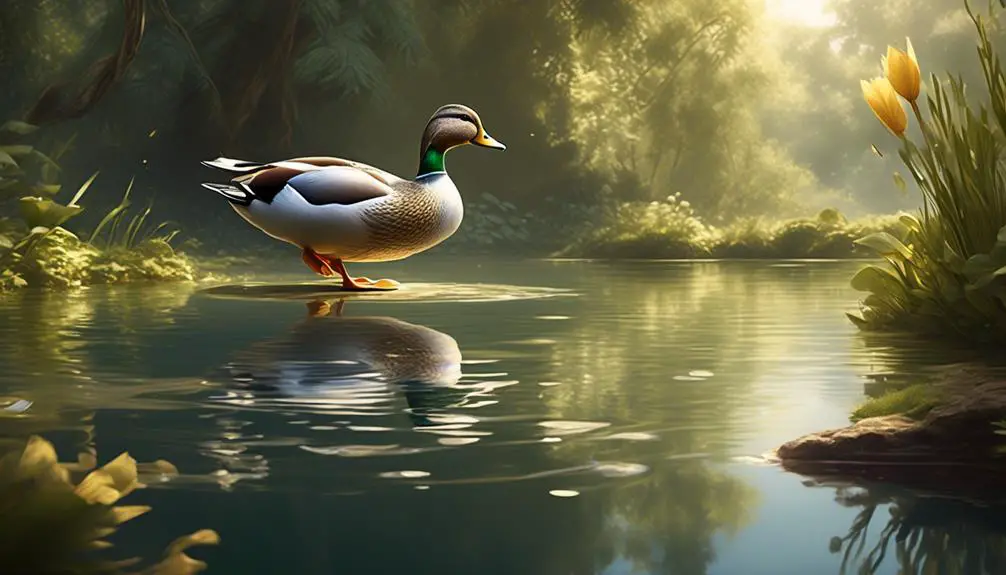
Ducks, with their water-repellent feathers, possess a remarkable adaptation that allows them to effortlessly float and navigate through the water. The key to their buoyancy lies in the structure of their feathers. Each feather has barbs that latch together, creating tiny air bubbles that increase buoyancy. These air bubbles not only help ducks float but also provide insulation, keeping them warm in cold water.
When ducks paddle their webbed feet, they generate forward propulsion. However, it’s the feathers that play a crucial role in keeping them afloat. The water repellent nature of their feathers allows water to slide off their backs, preventing them from becoming waterlogged. This significantly reduces drag, making it easier for ducks to move through the water.
Furthermore, the feathers also help ducks maintain stability while floating. The evenly distributed air bubbles trapped within the feathers create a balanced weight distribution, preventing them from tipping over or sinking. This allows ducks to bob in and out of the water effortlessly, as they engage in activities such as preening, feeding, and socializing.
Barbs on Duck Feathers for Buoyancy
With their water-repellent feathers providing buoyancy, ducks rely on the intricate structure of their barbs to maintain stability and effortlessly float on the water’s surface. The barbs on a duck’s feathers play a crucial role in their ability to stay afloat. These barbs are arranged in a way that allows them to interlock, creating a tight network that traps air and forms tiny air bubbles. These air bubbles increase the buoyancy of the feathers, helping the ducks stay above the water.
To give you a better understanding, here is a table depicting the structure of a duck feather and the function of its barbs:
| Structure of a Duck Feather | Function of Barbs |
|---|---|
| Central Shaft | Provides support |
| Barbs | Interlock to trap air |
| Barbules | Connect barbs together |
| Hooklets | Keep barbs in place |
| Vane | Increases surface area |
As you can see, the barbs on a duck’s feathers work together to create a stable and buoyant structure. The interlocking of the barbs ensures that the feathers stay in place, while the trapped air increases buoyancy. This allows ducks to effortlessly float on the water’s surface, maintaining stability and enabling them to navigate their aquatic environment with ease.
Webbed Feet and Floating Abilities of Ducks
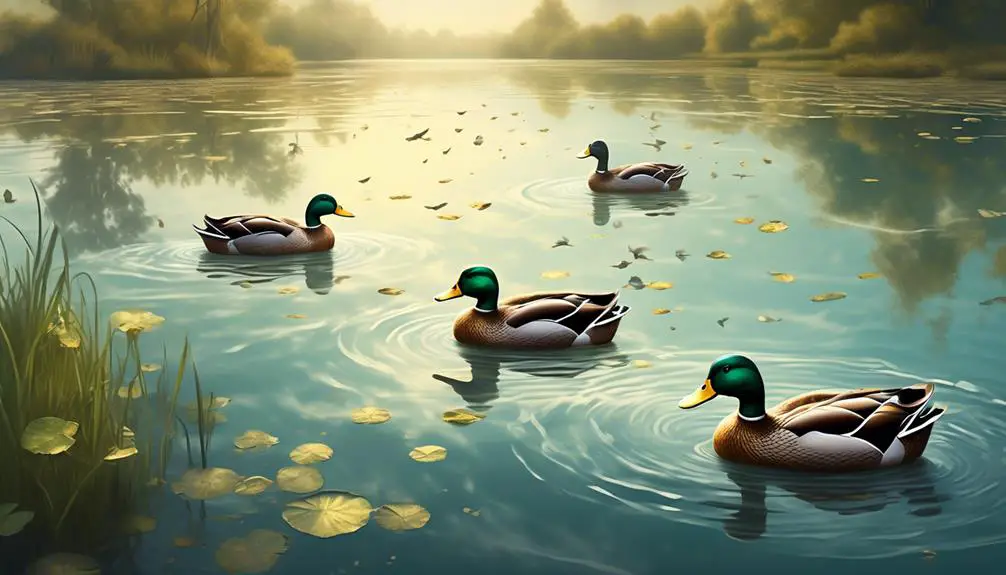
Ducks possess webbed feet that play a crucial role in their floating abilities. The webbing between their toes provides a larger surface area, allowing them to paddle through the water efficiently.
As ducks paddle, the feathers on their bodies, with their water-repellent properties, help maintain their buoyancy, preventing them from sinking.
The combination of webbed feet and feather buoyancy mechanism enables ducks to effortlessly float on the water’s surface.
Feather Buoyancy Mechanism
The unique feather structure and webbed feet of ducks enable them to effortlessly float and remain buoyant on the water’s surface. Ducks possess a remarkable feather buoyancy mechanism that allows them to maintain their position on the water. The feathers on a duck’s body are water repellent, preventing water from saturating their plumage. Additionally, these feathers have barbs that interlock, creating tiny air bubbles that increase buoyancy. This feather structure acts as a natural life jacket, providing support and preventing the duck from sinking. While ducks use their webbed feet to paddle, it is the feathers that truly enable them to stay afloat. The combination of webbed feet and the buoyant nature of their feathers allows ducks to effortlessly glide across the water, showcasing their remarkable floating abilities.
| Feather Buoyancy Mechanism |
|---|
| Ducks have water repellent feathers that prevent saturation. |
| The interlocking barbs on duck feathers create tiny air bubbles that increase buoyancy. |
| The feather structure acts as a natural life jacket, keeping ducks afloat. |
| Webbed feet enable ducks to paddle through the water. |
| The buoyancy provided by feathers allows ducks to effortlessly float and remain buoyant. |
Webbed Feet and Paddling
Webbed feet and the paddling mechanism of ducks contribute to their remarkable floating abilities on water. Ducks have specialized feet with webs of skin between their toes, enabling them to propel themselves through the water efficiently. As they paddle their feet, the webbing spreads out, increasing the surface area and creating resistance against the water. This action generates forward movement while providing stability and buoyancy.
The webbed feet of ducks also act as a rudder, allowing them to change direction quickly. By pushing against the water with their feet, ducks can maintain their position and remain afloat effortlessly. Additionally, the buoyancy provided by their webbed feet enables ducks to float on the surface, making them excellent swimmers and allowing them to navigate their aquatic habitats with ease.
Planktons: Microorganisms Floating on Water
Planktons effortlessly float on the surface of both seawater and freshwater, thanks to their flattened bodies and strategically placed spikes that help distribute their weight. These microorganisms, which are found in both marine and freshwater ecosystems, have adapted to their environment in a way that allows them to remain buoyant.
The flattened body shape of planktons, coupled with their spikes, allows them to spread out their weight over a larger area, increasing their buoyancy and enabling them to float effortlessly. This unique adaptation is crucial for their survival, as it allows them to stay near the water’s surface, where they can access sunlight for photosynthesis.
Additionally, the larger surface area compared to their size enables planktons to move easily with the currents, maximizing their chances of encountering food and mates. In freshwater environments such as lakes and rivers, planktons have the ability to move vertically, using their spikes to control their position in the water column.
Flattened Bodies and Spikes of Planktons
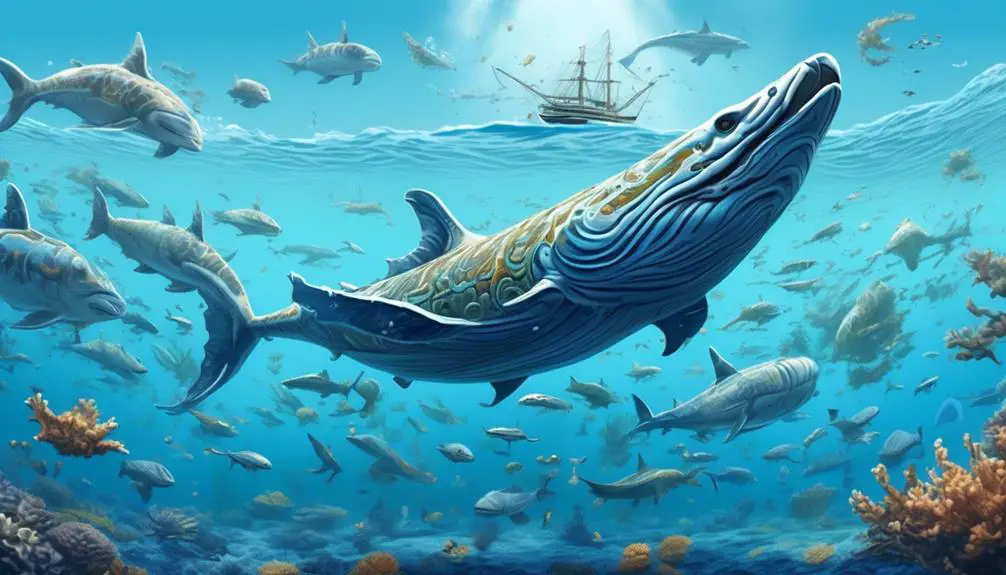
With their flattened bodies and strategically placed spikes, planktons possess unique adaptations that allow them to effortlessly float on the surface of both seawater and freshwater. These adaptations enable planktons to spread out their weight over a large area, increasing their buoyancy and preventing them from sinking. The flattened bodies of planktons provide a larger surface area compared to their size, allowing them to stay afloat. Additionally, the spikes on their bodies help in maintaining stability and balance while floating. To provide a visual representation of these adaptations, a table is presented below:
| Adaptation | Function |
|---|---|
| Flattened bodies | Increase surface area, enhancing buoyancy |
| Strategically placed spikes | Maintain stability and balance |
The flattened bodies of planktons allow them to effectively distribute their weight, preventing them from sinking. This adaptation is crucial for their survival as it enables them to remain on the water’s surface where they can access sunlight for photosynthesis. Furthermore, the strategically placed spikes on their bodies provide additional support and help them maintain their position while floating. These spikes act as stabilizers, minimizing the chances of tipping over or getting submerged. Overall, the unique combination of flattened bodies and spikes allows planktons to effortlessly float on water, making them highly adapted to their aquatic environment.
Floating in Colonies: Planktons on the Surface
Plankton communities play a crucial role in aquatic ecosystems. Floating in colonies, planktons can be found on the surface of the water, creating a dynamic and interconnected web of microorganisms.
Their ability to move collectively and spread out their weight over a large area allows them to float easily, contributing to their survival and the overall balance of the ecosystem.
Understanding the dynamics and importance of plankton communities is essential for studying and preserving the delicate balance of aquatic ecosystems.
Plankton Communities and Dynamics
Floating on the surface of the water, a diverse community of microorganisms known as plankton can be observed. These plankton exhibit intricate dynamics and form colonies. Plankton communities are composed of various types of organisms, including phytoplankton (such as algae) and zooplankton (such as small crustaceans and larvae).
These communities play a vital role in aquatic ecosystems. They serve as the primary source of food for many larger organisms. The dynamics within plankton communities are complex and constantly changing. They are influenced by factors such as temperature, nutrient availability, and predation.
Plankton can move in unison, forming large aggregations known as blooms. These blooms can be observed as discoloration on the water’s surface. They can have significant ecological impacts. Blooms affect water clarity, oxygen levels, and the overall health of the ecosystem.
Studying the dynamics of plankton communities is crucial for understanding and managing aquatic environments.
Role in Aquatic Ecosystems
In aquatic ecosystems, the presence of planktons floating in colonies on the water’s surface serves as a vital component of the intricate food web and ecosystem dynamics.
Planktons, consisting of microorganisms such as algae and bacteria, play a crucial role in the transfer of energy from the lower trophic levels to the higher ones. As they float on the surface, they serve as a food source for a variety of organisms, including small fish, crustaceans, and filter-feeding invertebrates. This makes them an important link in the food chain, supporting the growth and survival of higher-level predators.
Additionally, planktons contribute to the overall productivity of the ecosystem by performing photosynthesis, releasing oxygen, and absorbing carbon dioxide. Their presence and abundance influence water quality, nutrient cycling, and the overall health of aquatic ecosystems.
Ant Rafts: How Ants Stay Afloat
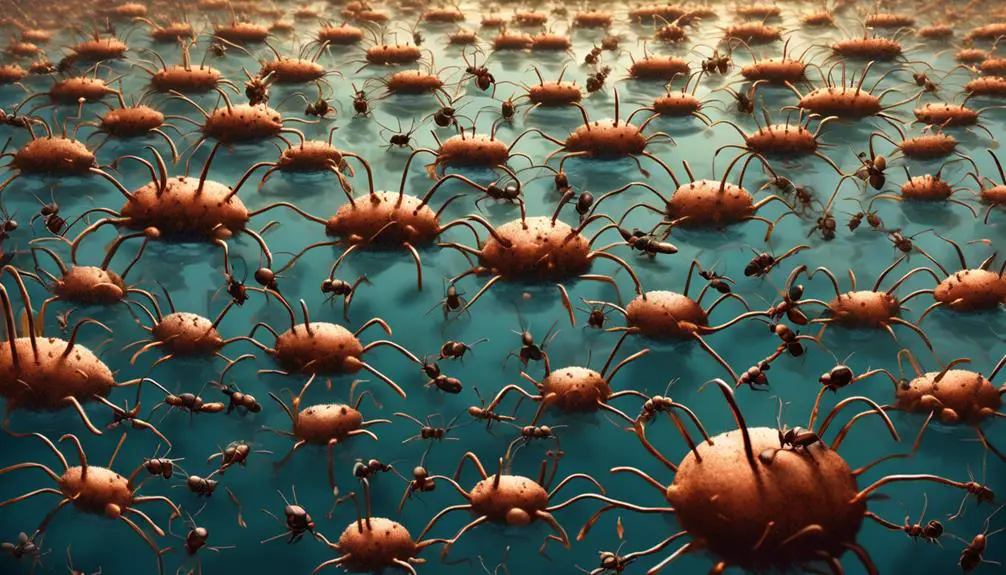
Ants have a fascinating ability to stay afloat by forming rafts when they find themselves in water. When ants come into contact with water, they exhibit a remarkable behavior that allows them to survive. As individual ants aren’t good swimmers and struggle to stay above the water surface, they quickly realize that their strength lies in numbers. By joining forces, ants can create a buoyant structure known as an ant raft.
To form an ant raft, the ants link their bodies together using their legs, mandibles, and antennae. This creates a network of interconnected ants that floats on the water’s surface. The ants on the periphery of the raft grip onto nearby objects such as leaves or twigs, anchoring the raft and preventing it from drifting away. Meanwhile, the ants in the center of the raft generate a protective layer of air bubbles that further enhance buoyancy.
The ability of ants to form rafts is crucial for their survival in water. By staying together, they increase their chances of survival as a group. The raft provides protection from predators and also helps to maintain the temperature and humidity levels necessary for their survival. This remarkable behavior allows ants to stay afloat for extended periods, sometimes for days, until they can find solid ground or until the water recedes.
Joining Bodies and Increasing Surface Area
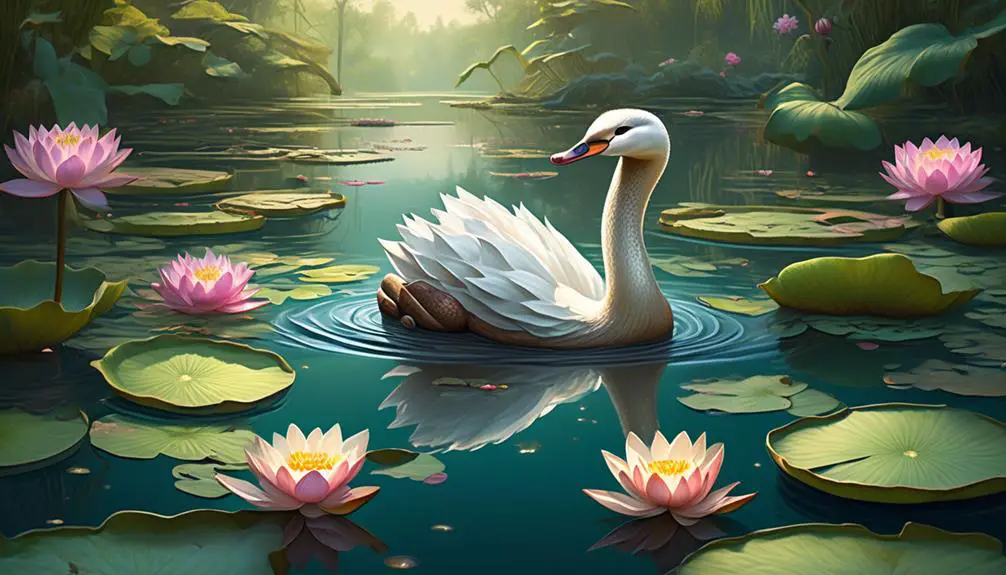
When multiple ants of the same species come into contact with water, they’ve the remarkable ability to join their bodies together, creating a network that increases their surface area and allows them to stay afloat.
This behavior, known as ant rafting, is a survival strategy employed by certain ant species. By linking their bodies, the ants form a floating structure that can support the weight of the entire colony. The ants interlock their legs and mandibles, creating a strong and cohesive raft.
This network of interconnected ants effectively distributes their weight over a larger area, reducing the overall pressure on the water’s surface and preventing them from sinking. The increased surface area also allows the ants to take advantage of surface tension, which helps them remain buoyant.
Additionally, the ants release chemicals called hydrocarbons, which are believed to further enhance the cohesion and water repellency of the raft.
Through this remarkable adaptation, ants can survive for extended periods on the water’s surface, even in challenging conditions.
Survival Strategy: Ants Floating Together
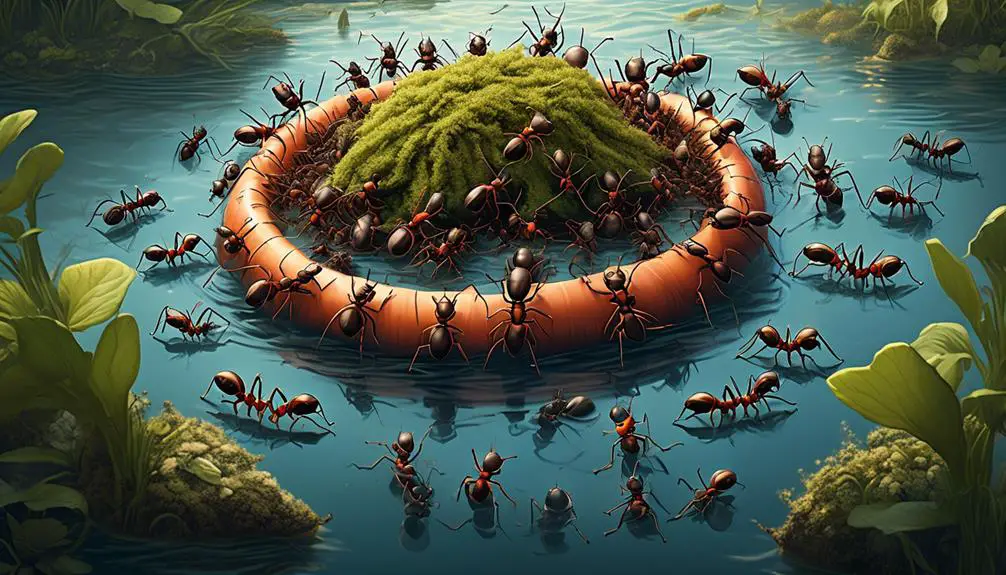
By linking their bodies together and creating a network that increases their surface area, ants employ a remarkable survival strategy to stay afloat on water. When ants of the same species fall into water, they quickly gather and form a raft by interlocking their bodies. This raft structure allows them to distribute their weight evenly and create buoyancy, preventing them from sinking. The interconnected ants create a network of tunnels and chambers that trap air, providing additional buoyancy and stability to the raft. This strategy enables the ants to survive for extended periods on the water’s surface, even in challenging conditions.
| Surface Area | Buoyancy | Survival Strategy |
|---|---|---|
| Increased | Enhanced | Linking bodies |
The ants’ ability to connect with each other and form a cohesive unit is critical to their survival. As they float together, they can navigate the water’s surface, avoiding predators and reaching food sources. Moreover, by staying together, ants ensure that all members of their colony remain safe and have a chance to survive. This collective behavior exemplifies the remarkable adaptability and resourcefulness of ants in their quest for survival. Through their innovative strategy of linking their bodies together and increasing their surface area, ants demonstrate the power of cooperation and unity in the face of adversity.
Corgis: Floating in Shallow Water
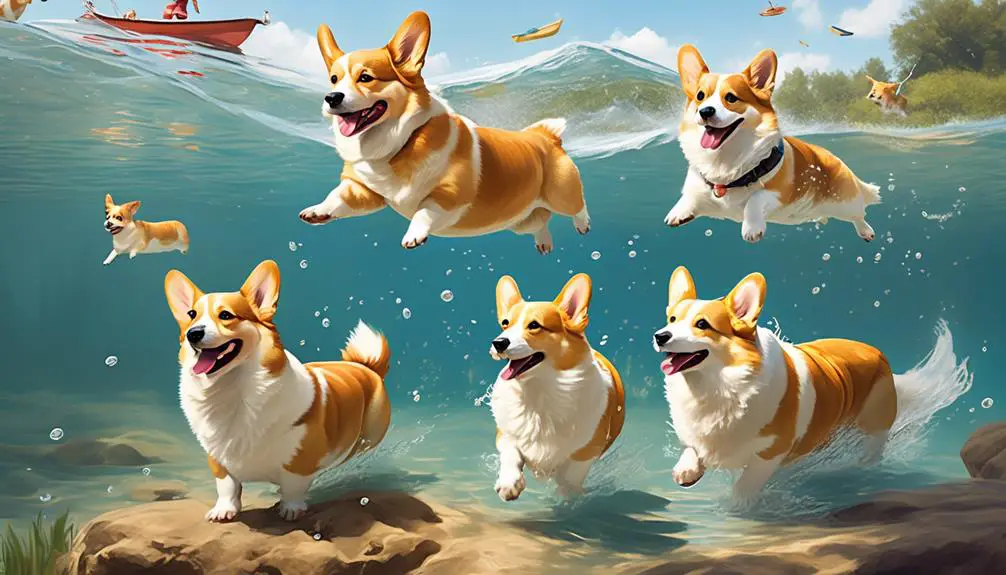
In the realm of animals that utilize unique strategies for staying afloat, let’s now turn our attention to corgis and their intriguing ability to float in shallow water. Corgis, with their barrel-shaped chests and short, stout legs, aren’t known for being excellent swimmers. Instead, they prefer to engage in the activity of floating, keeping their heads above the water level. Their distinct shape and size make them easily distinguishable from other dog breeds. While corgis enjoy splashing around in water, they aren’t particularly fast swimmers. Floating is the preferred activity for corgis in water.
When observing corgis floating in shallow water, it’s clear that they exhibit a relaxed and buoyant posture. The water supports their weight, allowing them to effortlessly remain on the surface. Corgis rely on their natural buoyancy and paddle gently with their legs to maintain their position. Their short legs and barrel-shaped chests aid in distributing their weight evenly, making it easier for them to stay afloat.
It is worth noting that corgis aren’t capable of swimming long distances or in deep water. Their floating behavior is most commonly observed in shallow water, where their feet can still touch the ground if needed. This behavior may be attributed to their breed’s historical use for herding cattle, as their low center of gravity and buoyancy would have made them more agile in marshy or flooded areas.
Barrel-shaped Chests and Short Legs of Corgis
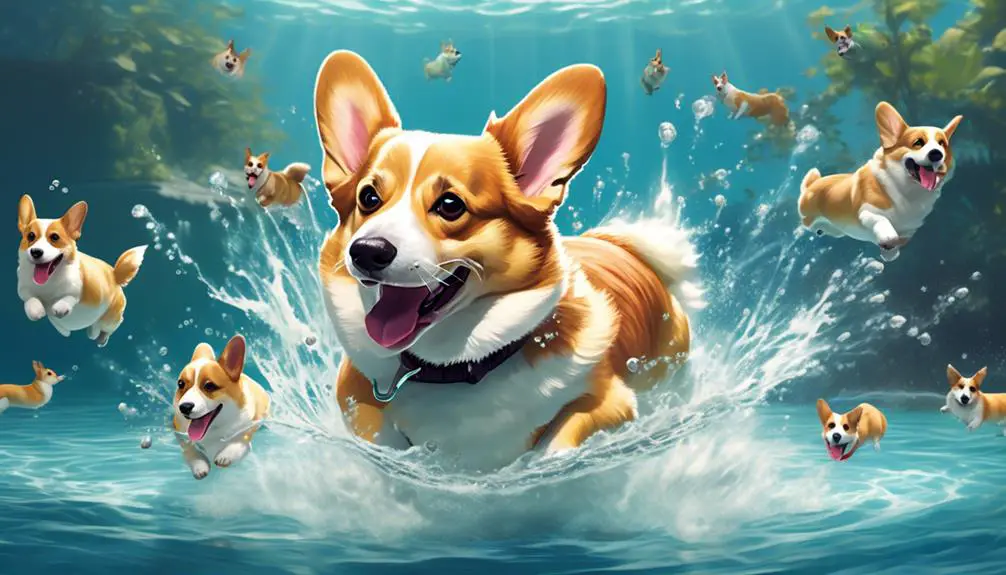
Corgis possess barrel-shaped chests and short, stout legs, which contribute to their unique floating ability in shallow water. The barrel-shaped chest provides buoyancy and stability, allowing corgis to stay afloat effortlessly. This chest shape creates a larger surface area in proportion to their body weight, enhancing their ability to remain buoyant.
Additionally, the short and stout legs of corgis play a crucial role in their floating capability. These legs are positioned closer to the body, minimizing drag and making it easier for corgis to navigate through the water. Their compact limbs also help in maintaining balance and stability while floating.
The combination of the barrel-shaped chest and short legs gives corgis a distinct appearance and allows them to enjoy the water without the need for intense swimming. Instead, they can leisurely float on the water’s surface, keeping their heads above water and enjoying their time in shallow areas.
It’s important to note that while corgis have the ability to float, they should always be supervised when near water to ensure their safety.
Preference for Floating: Corgis in Water
With their unique physique and distinctive features, corgis exhibit a distinct preference for floating on the water’s surface rather than engaging in vigorous swimming activities. Corgis have barrel-shaped chests and short, stout legs, which prevent them from being excellent swimmers. Instead, they prefer to float in shallow water, keeping their heads above the water level. This behavior can be observed when corgis are in pools, lakes, or even bathtubs. To illustrate this preference further, the table below compares the floating behaviors of corgis with other animals that float on water.
| Animals | Floating Behavior |
|---|---|
| Ducks | Excellent swimmers, can float and bob |
| Planktons | Microorganisms that float on the surface |
| Ants | Can form a raft to stay afloat |
| Corgis | Prefer floating activities |
| Worms | Can temporarily float on water |
As seen in the table, corgis stand out with their preference for floating over swimming. Their barrel-shaped chests and short legs make them easily distinguishable from other dog breeds. Although they enjoy splashing around in the water, corgis are not fast swimmers. Floating is their preferred activity in water, allowing them to relax and enjoy their time without the need for vigorous paddling.
Worms: Floating Temporarily on Water
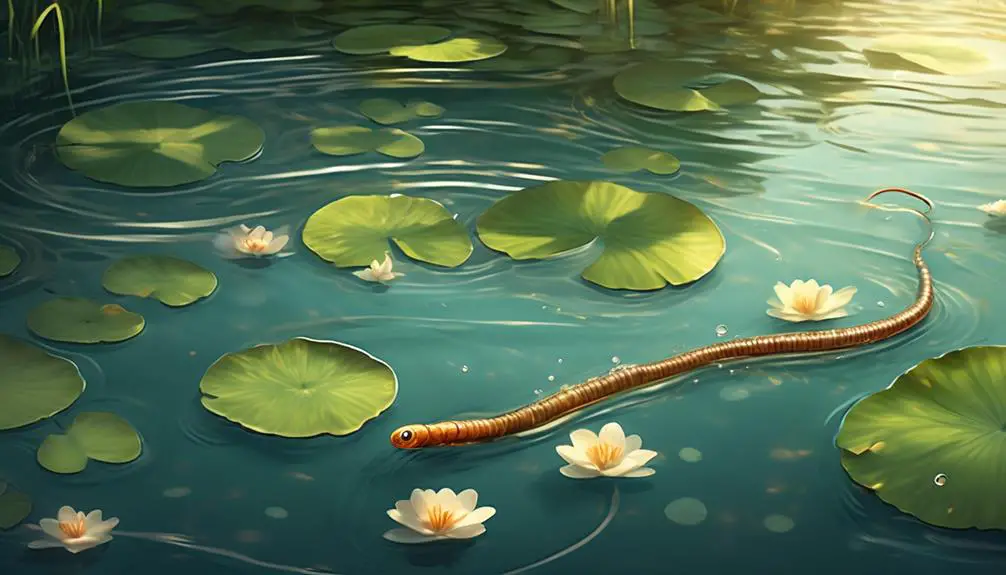
Worms, such as earthworms, possess the ability to temporarily float on water. This floating adaptation is essential for their survival, as they come up to the surface after heavy rains to obtain oxygen and ensure their survival.
While they can’t stay afloat for long periods or swim, their temporary buoyancy mechanism allows them to serve as a potential food source for fish before eventually sinking.
Floating Adaptation in Worms
Floating temporarily on water, worms possess a unique adaptation that allows them to survive on the surface for a limited period of time. This adaptation is primarily due to their slim, elongated bodies and the presence of a special hydrophobic coating on their skin. The hydrophobic coating helps to repel water, preventing it from seeping into the worm’s body and causing it to sink. Additionally, worms have a muscular body wall that enables them to contract and expand, creating a slight buoyancy that allows them to float. However, it is important to note that this floating ability is temporary and dependent on certain conditions, such as the presence of moisture on the surface of the water. Once the moisture evaporates or the worm becomes wet, it will eventually sink.
| Floating Adaptation in Worms |
|---|
| Slim, elongated bodies |
| Hydrophobic coating |
| Muscular body wall |
Temporary Buoyancy Mechanisms
Slim, elongated bodies and a hydrophobic coating on their skin contribute to the temporary buoyancy mechanisms observed in worms floating on water. When worms are on the surface of the water, their elongated bodies create a larger surface area, enhancing their buoyancy.
The hydrophobic coating on their skin repels water, preventing it from seeping into their bodies and adding weight. This coating also creates a barrier between the worm and the water, reducing friction and allowing the worm to float more easily.
Additionally, worms may excrete mucus, which further reduces friction and aids in their floating ability. However, it’s important to note that worms can only float temporarily on water. Without any active means of propulsion or control, they eventually sink and return to their subaquatic habitats.
Survival on the Surface: Worms and Fish Food
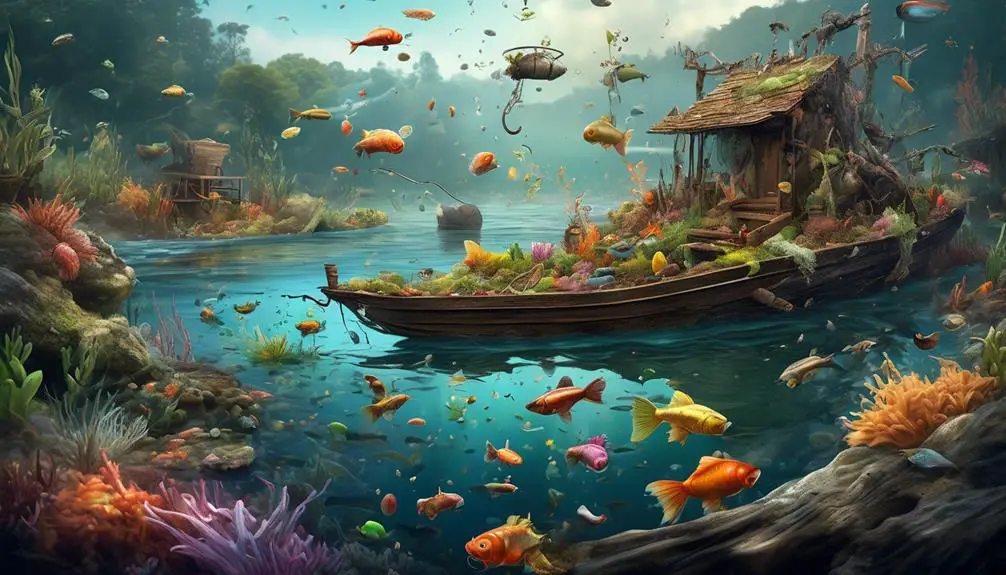
Surviving on the surface of the water, worms play a crucial role as a source of food for fish. While they may not have the ability to swim or stay afloat for long periods, worms can temporarily float on the water’s surface under certain conditions. After heavy rains, worms come up to the surface in search of oxygen and to escape waterlogged soil. This temporary buoyancy allows them to be easily accessible to fish, serving as a valuable food source.
The ability of worms to float on water is attributed to their body structure and the presence of air bubbles. Worms have a streamlined body shape with a slimy mucus layer, which helps reduce friction and enables them to glide on the water’s surface. Additionally, they can trap air within their bodies by swallowing it or producing mucus bubbles. These air bubbles increase their buoyancy and prevent them from sinking immediately.
While floating, worms are vulnerable to predation by fish. Fish detect the movements and vibrations caused by the presence of worms on the water’s surface, making them an enticing and easily accessible prey item. This interaction between worms and fish plays a vital role in the aquatic food chain, as fish rely on worms as an important source of nutrition.

Erzsebet Frey (Eli Frey) is an ecologist and online entrepreneur with a Master of Science in Ecology from the University of Belgrade. Originally from Serbia, she has lived in Sri Lanka since 2017. Eli has worked internationally in countries like Oman, Brazil, Germany, and Sri Lanka. In 2018, she expanded into SEO and blogging, completing courses from UC Davis and Edinburgh. Eli has founded multiple websites focused on biology, ecology, environmental science, sustainable and simple living, and outdoor activities. She enjoys creating nature and simple living videos on YouTube and participates in speleology, diving, and hiking.
- WILDLIFE THEMED T-SHIRTS
Cute Hedgehog Embroidered: Love Wildlife, Protect Nature Wildlife conservation tees
$35.00







